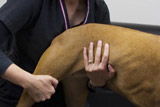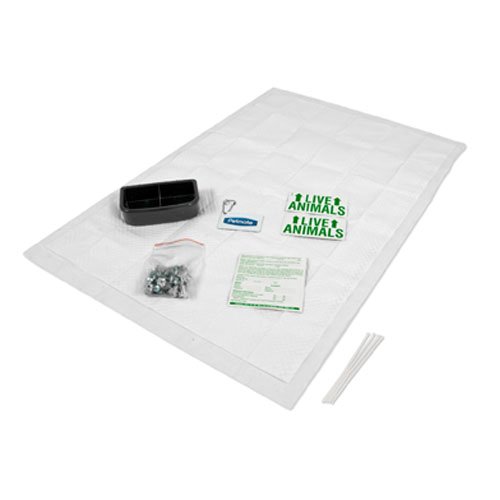

The very first signs of hip dysplasia in dogs can be noticed in a number of ways. Maybe you’ve taken your puppy or young dog home, and on its first visit to the veterinarian, the perceptive doctor notices that its hips don’t feel quite normal. Or perhaps you noticed that it has an odd way of running or jumping, and you bring it to the attention of the veterinarian. Your vet recommends that your dog have x-rays done and after looking at the x-rays, he/she informs you that your dog has hip dysplasia.
What does that mean? Dysplasia simply means ‘not properly formed’. Therefore, your dog’s hip joint was not properly formed. Now all sorts of questions start popping up. Why did this happen? Is my dog going to be able to live a happy life? How is this going to affect me? What will this cost me in the future?
Hip dysplasia happens while the dog is developing, and therefore is mostly a genetic disorder. There are many genes that contribute to proper formation of the hip joint. Therefore, hip dysplasia is not an easy problem to predict or get rid of, unlike some other genetic disorders that are caused by only one gene. Some breeds, such as Labrador Retrievers and German Shepherds, tend to have more hip dysplasia than other breeds.
Just because genetics is mostly to blame does not necessarily mean that you have no control over whether or not your dog has hip dysplasia. It is very important to do research into the breed you are getting. If that breed has a high chance of hip dysplasia, make sure you go to a breeder who has no history of hip dysplasia, and who has gotten the parents of the puppies tested for hip dysplasia. Also, have your new puppy checked by a veterinarian for hip dysplasia before committing to purchasing the puppy. Although this may not catch all cases of hip dysplasia, it should certainly catch the worst cases.
This brings us to another concern. What if you already purchased the puppy? Well, the first thing you will want to know is how severe the hip dysplasia is. It can range in severity from where it is hardly noticeable and does not affect the dog to cases where the arthritis will be so bad in mid-life that the dog may have limited mobility. If the hip dysplasia is severe, you may have to look into the possibility of surgery, and that is a financial commitment that you will have to carefully consider. At this point in time, in veterinary medicine, total hip replacements only have variable success. However, a very common surgery that can also help is called ‘femoral head osteotomy’. This surgery involves reshaping the femur bone and the surrounding muscles and ligaments to create a new, hopefully stronger joint. This surgery has a pretty good success rate, but you have to take into consideration the financial commitment and the long recovery time, and how that will affect your dog, and you.
Whether the hip dysplasia is mild or severe, you should pay heed to the following advice. The most important thing you can do for your dog is to keep it FIT! Do not let your dog put on any extra weight. That extra weight puts more pressure on already unstable and painful hip joints. A heavier dog will progress into the severe signs of hip dysplasia (unwillingness to stand or walk, and severe pain) MUCH more quickly than a fit dog. A fit dog with severe hip dysplasia can actually live a normal lifespan with minimal problems!
A fit dog is one that eats and exercises properly. Continuing proper nutrition throughout your dog’s life will benefit it greatly as it ages. Many owners of dogs with hip dysplasia supplement their food with chondroitin and glucosamine to strengthen their joints. If this appeals to you, it is something you should talk to your vet about to make sure you use the proper dose and product for your dog. Exercise will strengthen the muscles around the joint to help stabilize it. The best exercise you can give your dog is swimming, because it is not a weight-bearing exercise. Over-exercising your dog, especially an older dog, will make the joint painful. So be careful to tailor the amount of exercise to what your dog can handle.
Another issue to take into consideration is avoiding pressure on the rear end. You can do this by making people, especially children, aware that your dog has what you can call ‘painful back legs’. Over time, you will learn the subtle signals that your dog will give when its hips are bothering it. Also, as it gets older, you will probably start giving it pain medication.
This is a lot to think about. Hip dysplasia is a serious problem that you would ideally like to avoid, but, on the other hand, it is not a death sentence. With proper care, your dog can live a long and happy life. Hopefully, as your dog ages and gets into all the sorts of trouble that young dogs get into, its hip dysplasia will be the least of your worries!
By Ashley O’Driscoll – Pets.ca writer
 Train Your Puppy Properly
Do you want to play catch?
Train Your Puppy Properly
Do you want to play catch?
 Dogs :: Stomach Torsion in Dogs and How to Prevent It (Page 1 of 2)
Also known as gastric torsion, bloat, and GVD (gastric dilat
Dogs :: Stomach Torsion in Dogs and How to Prevent It (Page 1 of 2)
Also known as gastric torsion, bloat, and GVD (gastric dilat
 Boosting Your Dogs Health Through Food
We would do anything to keep
Boosting Your Dogs Health Through Food
We would do anything to keep
 Traveling Safely with your Pet
Since this is the season tha
Traveling Safely with your Pet
Since this is the season tha
 Tub Time For Dogs! Hints and Tips for Bathing Your Dog!
Tub Time! Tips for Bathing Your Dog!
Most of us are a bit
Tub Time For Dogs! Hints and Tips for Bathing Your Dog!
Tub Time! Tips for Bathing Your Dog!
Most of us are a bit
Copyright © 2005-2016 Pet Information All Rights Reserved
Contact us: www162date@outlook.com